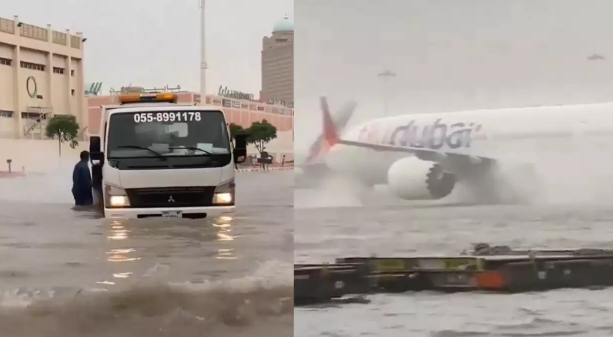Dubai, which usually experiences an arid climate and scorching temperatures, plunged into chaos on Tuesday as heavy rain battered the United Arab Emirates (UAE), disrupting air travel and prompting widespread flooding across the desert country. The unexpected deluge not only brought the bustling city to a standstill but also raised concerns about the increasingly evident impact of climate change on extreme weather events in the region.
On Tuesday, Dubai International Airport, the world’s busiest air hub for international passengers, was forced to divert numerous incoming flights as the heavy downpour rendered flight operations dangerous. The airport, which typically welcomes over 100 flight arrivals on a typical evening, witnessed a rare suspension of arrivals, followed by a gradual resumption 25 minutes later. Despite the resumption of departure flights in the evening, flight operations encountered delays and cancellations.

Videos circulating on social media showed planes taxiing on flooded runways.
Dubai, which usually experiences an arid climate and scorching temperatures, plunged into chaos on Tuesday as heavy rain battered the United Arab Emirates (UAE), disrupting air travel and prompting widespread flooding across the desert country. The unexpected deluge not only brought the bustling city to a standstill but also raised concerns about the increasingly evident impact of climate change on extreme weather events in the region.
Dubai Airport right now
— Science girl (@gunsnrosesgirl3) April 16, 2024
pic.twitter.com/FX992PQvAU
On Tuesday, Dubai International Airport, the world’s busiest air hub for international passengers, was forced to divert numerous incoming flights as the heavy downpour rendered flight operations dangerous. The airport, which typically welcomes over 100 flight arrivals on a typical evening, witnessed a rare suspension of arrivals, followed by a gradual resumption 25 minutes later. Despite the resumption of departure flights in the evening, flight operations encountered delays and cancellations.
Videos circulating on social media showed planes taxiing on flooded runways and cars half-submerged at the airport’s parking lot. Access roads leading to the airport were also inundated.
Key infrastructure in the city, including flagship shopping centres like Dubai Mall and Mall of the Emirates, were flooded and ankle-deep water inundated at least one Dubai Metro station. Roads collapsed, residential communities were submerged, and reports emerged of leaks from roofs, doors, and windows in various households.
Dubai mall flooding, pic.twitter.com/C9qwpLfDI5
— LIONE$$ (@The_Lioness13) April 16, 2024
Current weather in Dubai pic.twitter.com/v6dqxaA97A
— CLEAN CAR CLUB (@TheCleanCarClub) April 16, 2024
The impact of the storm extended beyond Dubai, with the entire UAE and neighbouring Bahrain experiencing similar scenes of flooding and chaos. According to news agency AFP, schools across the Emirates were closed, and further storms, including hail, are forecasted for today, prompting authorities to extend remote working arrangements for government employees.
Watch: Dubai's Metro Station Flooded, Streets Waterlogged Due To Heavy Rainfall
— NDTV (@ndtv) April 17, 2024
(📽️: Getty) #DubaiRains #DubaiMetro
Read More: https://t.co/OxhlHpd4AB pic.twitter.com/dHNiBOJh3S
These visuals are from Dubai Mall.
— Baba Banaras™ (@RealBababanaras) April 17, 2024
No development can fight with nature. Nature is almighty pic.twitter.com/qhg15P0kco
In Oman, where the storms initially struck, the devastation was particularly grim, with flash floods resulting in the deaths of 18 people, including children. Bahrain too experienced flooding due to the storms.
Both Oman and the UAE, hosts of the previous year’s COP28 UN climate conference, have previously cautioned about the increased likelihood of flooding due to global warming.





